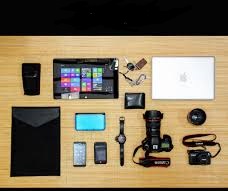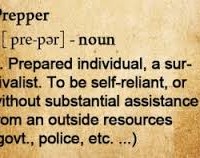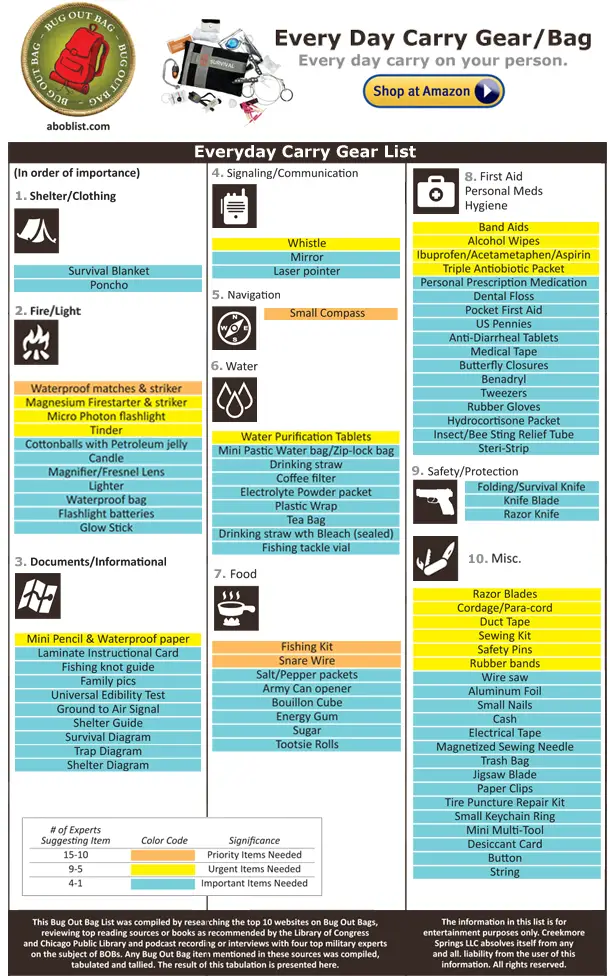Preparing for every emergency is a daunting task. We do it because it is in our nature.
We try to be thorough and play out various scenarios in our heads and prepare for every possible contingency.
Although luck and chance have a hand in our outcomes, we still attempt to make every effort to cover all our bases.
Having a 72 hour (3 day) Bug Out Bag at home and Get Home Bag at work or schools are positive measures in getting one prepared for the unexpected. However, I have to say it may not be enough.
 Ideally, during any crisis, we would always have direct accessibility to our well packed and prepared bags. But, this may not be the case.
Ideally, during any crisis, we would always have direct accessibility to our well packed and prepared bags. But, this may not be the case.
It is most likely that an event will occur during the course of a normal day. And it is very well possible that the event that suddenly and without warning occurs would prevent you from getting access to them. So what do you do?
Under those circumstances, there may be only two things keeping you from becoming just another statistic; the prepper skill set you possess in your head and the items you have on your person.
What is the function of Everyday Carry Gear (EDC)?
 Everyday carry gear or kit provides you with the necessary emergency items needed during the time you are without your more comprehensive bug out bags or supplies you would need during a crisis.
Everyday carry gear or kit provides you with the necessary emergency items needed during the time you are without your more comprehensive bug out bags or supplies you would need during a crisis.
It thus complements and completes your preparation repertoire. Ideally, this limited but effective gear will provide you with the necessary aid until you able to access your more complete emergency stash or get to safer surroundings.
Surprising enough, you probably already have items that in some ways serve as a kind of everyday carry gear and don’t even know it.
These are the items, tools and documents you carry on you during the course of the day. They are used to provide some form of preparedness, however usually not to address any apparent threat. Example of items commonly found in your purse, wallet, hat, clothes and hanging from your body are:
●Cash ●Medications ●Handkerchief ●Letter opener ●Napkins/Tissues
●Keys ●Mirror ●Cell Phone ●Nail File ●Hygiene items
●Watch ●Stationery ●Gum/Candy ●Identification Cards ●Sewing pins/needles
However, what separate many of these items from more useful Everyday carry gear are there limitations due to their specific use function and lack of redundancy qualities.
Nevertheless, EDC gear and kits have two major flaws that get home and 72 hours bag don’t have, the lack of ample supply of food and water.
What are the qualities of Everyday Carry Gear?
There is certain characteristics EDC products share in common. Everyday carry gear tends to be;
- Lightweight
- Compact
- Inconspicuous or low profile
- Redundant in providing various emergency preparedness functions
- High level of effectiveness when needed
Importantly, because of the restrictiveness of size and quantity, some of these survival items only provide a limited relief or response to the immediate urgent situation at hand.
These items can be carried or stored in various ways;
✔ On a keychain
✔ In your pocket
✔ Around your neck and or waist
✔ In or on you cap or hat
The 10 critical areas of emergency preparedness addressed by Everyday Carry gear or kit
Everyday Carry gear or kits are specifically and directly used to address your immediate emergency preparedness needs. These ten areas in order of importance are;
- Shelter/Clothing
- Fire & Light
- Documents/Informational
- Signaling/Communication
- Navigation
- Water
- Food
- First Aid-Personal Medication-Hygiene
- Safety & Protection
- Miscellaneous Items
As mentioned, there are some limits to the amount and variety of this type of emergency gear or equipment especially with food and water options you would carry.
Nevertheless, it is more than possible to find and collect items that fit each of the categories listed above.
Ideas for Everyday Use Kits
I have compiled a more comprehensive list on my home page that provides the kind of items you might consider when creating your own EDC bag or purchasing a ready-made kit.
Whichever type works best for you, keep in mind the products you purchase should emphasized quality (you wouldn’t want your item to malfunction or break during a crisis) and redundancy.
As an example you may buy a few different items that might provide ways to start a fire and give off illumination.
And eventhough water and food purchases might be limited, you should try whenever possible to have reasonable alternatives such as [easyazon_link asin=”B003MORJ1O” locale=”US” new_window=”default” nofollow=”default” tag=”aboblist-20″]candy with long shelf life[/easyazon_link], [easyazon_link asin=”B002M0EDG8″ locale=”US” new_window=”default” nofollow=”default” tag=”aboblist-20″]collapsible water bottle[/easyazon_link], etc… that may still provide you some level of coverage.
It is also imperative to note that even if you make an EDC or purchase one that is completely assembled, you will most likely need to replace or add other gear to your kit.
Best Practices for Your EDC Gear Use
 It is not enough to purchase and have in your possession an EDC kit or gear. You may one day come to use the contents of your bag. So the following are suggested everyday carry best practices.
It is not enough to purchase and have in your possession an EDC kit or gear. You may one day come to use the contents of your bag. So the following are suggested everyday carry best practices.
You need to be methodical in the carrying and keeping of your EDC gear. Always know where you place and carry all your items on you and at home.
Form a routine so not to forget them. For example, in the morning, when you are getting ready for the day, make sure to develop a routine to consistently place your gear on you the same way every day.
Then, at the end of the day, be habitual where you keep and store all these items. Then you most likely will have all of them ready for you to pack the next day.
Another measure to implement is to familiarize yourself with all the items in your repertoire.
Practice handling and repacking your gear especially if you purchase a complete, ready to use kit. Make this something you do on a consistent basis (at least 4 times a year).
Replace items that expire. Make all attempts at practicing using your contents. I know it is sometimes time consuming but you need to know whether the items you purchase work properly.
Lastly, your whole family should have some form of Everyday Carry gear or kit. They too should follow the same routines you put in place.
As for your children, it may be necessary to omit or replace items that might be questionable because of school policy or regulations.
This however should not deter you from giving one to your kids. In the end, there are factors that are out of your control that may determine you and your loved ones fate. But as the sayings goes “Chance favors the prepared.”


